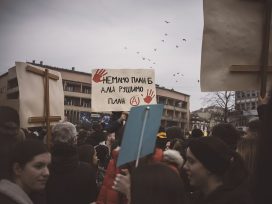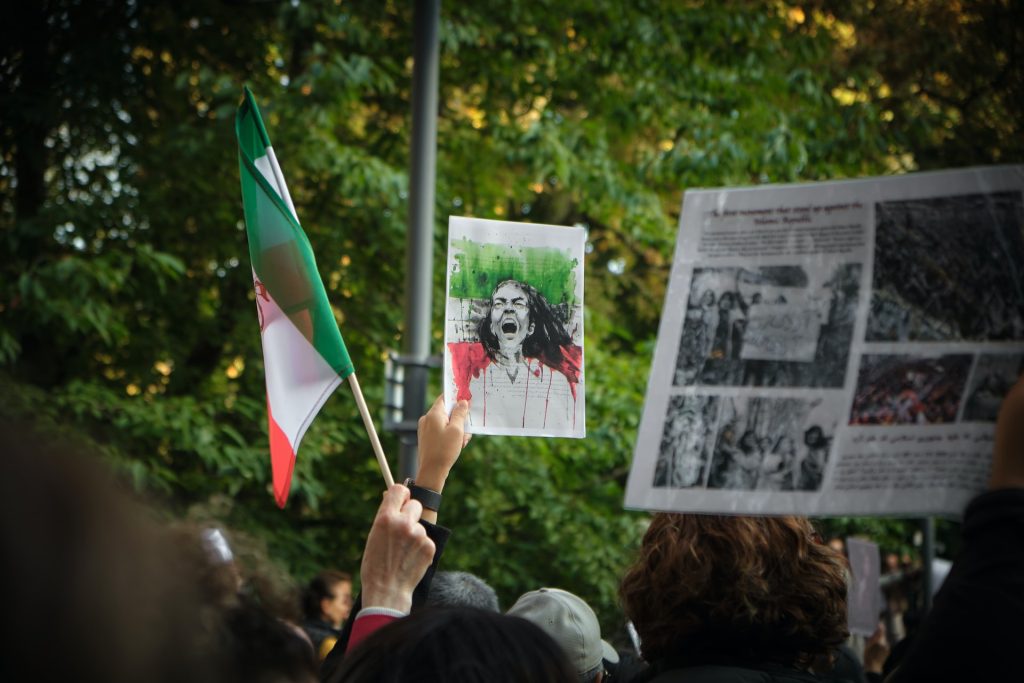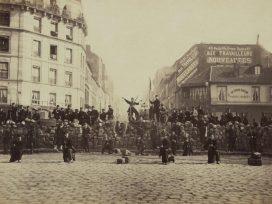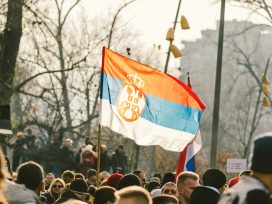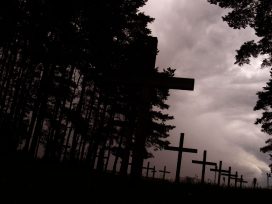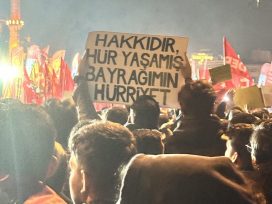Iran is seeing its largest protests in years, triggered by the violent death of Mahsa Jina Amini in police custody, after morality enforcers arrested her for not wearing a hijab in accordance with regulations. It is no coincidence that the main slogan being chanted by protesters is ‘Woman, Life, Freedom’. Hostility to women has always been one of the principal political pillars of the Islamic Republic of Iran.
‘If the Islamic Revolution has no other result than the veiling of women, that alone would be enough for the Revolution’, said Ruhollah Khomeini, the leader of the Revolution, once said. The Ayatollah’s first act, just days after returning from French exile and toppling the government of the last monarch, was to brandish the sword of his Revolution against women. Almost all the laws put in place during five decades of social gains for women were to fall victim to his idea of Islam.
Various progressive laws for the protection of women had been adopted in the years before the Revolution. These reforms had circumvented the Islamic law of Sharia. For the first time in Iranian history, divorce cases in family courts were heard by judges who had taken a legal exam, rather than by clerics. The court had sole authority to end a marriage, even when a husband did not want to separate from his wife. The unilateral right to divorce was abolished, and the court decided who received custody of children. Male polygamy was restricted to a single additional wife. Women’s right to work was supported and paid maternity leave and childcare were introduced.
The clergy denounced these laws as ‘the promotion of prostitution’ and predicted moral decline. Leftwing parties and groups criticized them as the ‘westernization’ of Iran. The two factions joined forces to set the Revolution in motion. ‘Women’s freedom is society’s freedom’, proclaimed the banners of the Iranian women who protested in 1979 against the new Islamic dress regulations and the loss of numerous rights. Iran’s women were the biggest losers of the Revolution.
Legislation on marriage and divorce was apparently so important to Khomeini that he repealed Iran’s progressive law on the protection of the family just 15 days after taking power. He lowered the age of marriage for girls to nine years old. Men were once again permitted to marry four women and have as many Shiite ‘temporary marriages’ as they wanted. Women no longer had the same right to divorce as men, who could get a divorce whenever they wanted. And female judges became a thing of the past.
Since then, schools in Iran – especially girls’ schools – can be veritable torture chambers: anyone who steps out of line must leave, and the lives of most students are hellish. Over the decades, things like a little pocket mirror, white sports socks, a hairband under the obligatory headscarf or a loose strand of hair have all been enough to provoke discrimination and exclusion.
The political Islam that gained prominence in the 1970s let itself be guided by the patriarchal worldview of Fiqh, the system of traditional Islamic jurisprudence. And it was women from impoverished, disadvantaged backgrounds, already more likely to experience violence than other women, who bore the brunt of the new laws. The main barrier for Iranian women – according to a recent analysis by the well-known feminists Mehrangiz Kar and Azadeh Pourzand – is not Islam, which can be interpreted in different ways depending on time, place and circumstance, but the specific nature of the Islamic Republic: a ‘theocratic system created out of the political and legal fusion of government and religion’.
The theocratic state can talk to and negotiate with its arch-enemies – but not with Iranian women. The political authorities are more scared of women than of their ideological rivals. Through women, the regime controls society. ‘From a legal perspective, it is women who have suffered most in the Islamic Republic’s more than forty-year-long experiment’, concludes Kar, a lawyer and human-rights activist.
It is now clear that if any profound change is to take place in Iran, it will be due to the women who have been making sacrifices for decades to achieve it, without letting themselves be intimidated. Women have been on the front line of the fight against injustice for years. They are not part of the powerful elite; they stand against it. They have become intimately familiar with the essence of the regime – and at a certain point have overcome it internally. That is their strength. A strength behind which large parts of the younger generation in particular are now rallying.
Why did the West not recognize this immense resentment, this rage in Iran much sooner and react appropriately? What prevented it from criticising the regime more harshly?
There are two reasons: one to do with foreign policy and the other to do with Iran’s domestic politics. From the foreign policy perspective, western debate about human rights in Iran has been paralysed for years by the not unreasonable fear of an Iranian nuclear bomb. The focus is the nuclear deal, negotiations on which are as old as the people now taking to the streets. This generation is completely indifferent to a deal.
In domestic politics, meanwhile, the opposition between supposed ‘reformers’ and ‘hardliners’ has enabled the regime to project an illusion of lively democracy to the rest of the world for decades, with apparently genuine power transfers and millions of voters. As if those elections had been free and fair, as if there was any genuine alternative in Iran.
The West’s failure
For too long we have failed to understand who actually embodies power in Iran. We have misinterpreted the labels identifying ‘reformers’ and their close associates from the beginning. We have been blind to the increasing meaninglessness of the ‘reform’ category itself. Being a reformer does not mean sympathising with public anger on the streets or supporting marginalized minorities. Being a reformer means not getting on the wrong side of the Supreme Leader. It means acting as a safety valve for the regime when the pressure in the system gets too high.
Only the Supreme Leader’s candidate can win an election. The Iranian constitution endows the leader with enormous power: Ayatollah Khamenei, who inherited the position in 1989 from the revolutionary leader Khomeini, has authority over the military, the Revolutionary Guard, the militias and law enforcement agencies, the security services, the judiciary and the state broadcasting service. He is the supreme ideologue who sets the guidelines, including for foreign policy. The US-Iranian political scientist Karim Sadjadpour talks of two parallel regimes working in concert: ‘Those with power take hostages, build nuclear programs, support regional militias, carry out assassinations and are inaccessible to western officials. Those without real power deny these activities and are accessible to western officials’.
The Islamic Republic of Iran is a dual state, with selected institutions managing the day-to-day affairs of state in the shadow of the much more powerful Supreme Leader. The latter has huge power but little accountability: he can shift all responsibility onto elected officials, in other words the president. The Revolutionary Guard is one of the pillars of his power. It works to crush mass protests and prevent a military coup. It has built up a corrupt black economy and founded a media holding company with which it spreads its propaganda to the people in an astonishingly modern guise.
All political factions in Iran are part of the Islamist establishment. They want to ensure the survival of the theocracy and the rule of God’s representative on earth. The various groups differ only in their methods. The means are different, but the goal is the same. Yet we still act as if there were a diametric opposition between liberal-progressive and illiberal-reactionary groups in Iran. We act as if our support for the reformers will bring about democratization in Iran. And we have still not come to grips with the peculiar inconsistency of their reform project, let alone understood the constitution of the republic.
The conventional categories used in our coverage of Iran have long missed the mark because we are only too willing to overlook the elephant in the room: the fact that the dictatorship of jurists places God’s sovereignty over human sovereignty. It claims to be the only true interpretation of Islam, with which the whole of society must align itself. It legitimizes politically motivated violence. It permits no separation between state and religion. The system has been virtually incapable of reform since 1979, notwithstanding all so-called ‘reformers’.
Reform as farce
‘Reform is something that can gradually change a foundation. A very valuable resource that requires many fewer sacrifices than a revolution’, says Maryam Karimbeigi, an opponent of the regime. ‘Our system fools you with reformers whose smiling faces conceal the workings of the system itself. The illusion that you have freedom of choice, that you can choose between two camps. The system has arrogated the resources and ideas of “reform” to itself, taken control of the concept, and destroyed the idea of reform so that we can no longer use it as a tool’.
The era of ‘reform’ generally refers to the opening of civil society under the first reformist president, Mohammad Khatami, who was in office from 1997 to 2005 and believed that democracy and theocracy were compatible – even though his role model, the revolutionary leader Khomeini, had had nothing good to say about democracy. Today’s reformers once belonged to the most radical forces in the first years of the Revolution and participated enthusiastically in the dismantling of women’s rights. Many see themselves retrospectively as ‘worse than the Taliban’. Were they driven by guilt, or the desire to make amends, when they insist that they are only pushing for the democratic Islam that the revolutionary leader had called for from the beginning? Have they not read any of Khomeini’s works?
In the first period of reform under Khatami, it seemed as if a new era had begun. Numerous newspapers and other publications were founded, legally recognized NGOs were established and the zeitgeist shifted towards greater freedom for women and more openness and contact with the West. But just a few years after Khatami left power, the reformist project had been mostly abandoned.
After eight years of Khatami’s presidency – a term of office that many people found so disappointing that they abstained from voting altogether in 2005 – the run-off presidential election was won by a man who was unfamiliar to many Iranians. He had run in the interests of the poor, he said, and promised to clear up corruption. It only took a few months for many to realize that Mahmoud Ahmadinejad was a serial liar installed by the Supreme Leader. Ahmadinejad believed he had been chosen to pave the way for the coming of the Twelfth Imam, the last successor of the Prophet Mohammed: the Mahdi, the Rightly Guided One, the messiah of Shia Islam, who according to doctrine fell into a well as a child and has lived in Occultation ever since, and whose reappearance will be preceded by a time of chaos throughout the world.
Stocking his cabinet with members of the Revolutionary Guard, Ahmadinejad prepared for the apocalypse and the return of the world saviour. His sectarian belief in the messiah, based on a literal understanding of the Quran, told him that Israel must be destroyed before the redeemer could appear. The most internationally notorious of his lies was that there was no Holocaust. Within Iran, meanwhile, the situation for dissidents and human-rights activists darkened. The number of executions quadrupled in Ahmadinejad’s first term of office from 2005 to 2009.
2009: the year of truth
The last hope of the reformist faction was the so-called Green Movement in 2009, when millions took to the streets to protest peacefully – and in vain – against the rigged election that returned Ahmadinejad to power.
It was a pivotal moment, a turning point, a year of truth. Thousands of protesters took to the streets to ask where the votes of millions of citizens had gone – a fundamental question in Iran since 1979, simply reworded and masked thirty years later in the phrase ‘Where is my ballot paper?’
But the uprising came to a brutal end – and a young woman became an icon of the failed rebellion. The YouTube video that showed the world Neda Agha-Soltan bleeding to death lasted forty-seven seconds. It is a testimony that captures the essence of everything that happened in Iran in 2009. A young philosophy student, hit by a bullet fired by the leader’s paramilitary troops, dies in the street, in the arms of her singing teacher, with whom she happened to be traveling, in the middle of a demonstration. Towards the end she fixes her gaze on the mobile phone recording her last seconds.
Neda, who shortly before her death had shouted ‘Down with the dictator’, was for the recently re-elected president of Iran the literal dregs of society. He referred to the three million people who had protested against electoral fraud in a silent march in Tehran as ‘dust and dirt’. For Ahmadinejad, they were the bad losers of the opposing camp, like depressed supporters ‘after a football match’. Ayatollah Khamenei, the Supreme Leader, dismissed all those asking where their votes had gone as a ‘depressive minority’. His Revolutionary Guard spoke of the ‘great conspiracy against the Iranian people’ and of a ‘colour revolution’ engineered by western secret services.
We only know the names of 78 people who were killed. But thousands were arrested, and many detainees were convicted in political show trials, with their absurd forced confessions broadcast on state television. Universities were ‘purified’ again, reformist newspapers were shut down and the internet increasingly became the ‘filternet’. But the West, led by US President Barack Obama, dithered and dragged its feet instead of acknowledging the Iranian demonstrators and siding with them from the beginning.
Western intellectuals – from Judith Butler to Slavoj Žižek and Noam Chomsky – issued an appeal in June 2009 that was intended as a sign of solidarity with the protesters but came across as half-hearted at best. On one hand, they said, foreign observers were right to criticize Iran’s government. They claimed to be inspired by the courage of the Iranian demonstrators and informed Tehran that only a government that allows its people to protest and debate freely can claim to represent the will of the people. On the other hand, however, ‘years of foreign-sponsored advertisements for democracy in various parts of the world have contributed to widespread, well-founded scepticism towards citizens’ movements claiming direct democratic legitimacy’. The ‘open letter in support of the protesters’ was less a declaration of solidarity than a soliloquy by leftwing intellectuals whose scepticism led them to reproduce the regime’s propaganda.
Five years after those protests, a video was finally made public. It showed the head of the Revolutionary Guard warning senior officials of a victory for the reformers in the 2009 election. Such a result would be a victory for counter-revolutionary forces: a ‘worry’ and a ‘red line’ for all revolutionaries. The video showed that after Khamenei condemned the post-election protests, his security forces decided to simply shut them down. In the presidential elections in 2013 and 2017, the reformers, who had been marginalized and forced to the right, had no option but to support the ‘centrist’ and ‘moderate’ Hassan Rouhani.
Rouhani’s campaign was based around the slogans ‘hope’ and ‘moderation’ and numerous promises to respect human rights: ‘Justice means that all those who want to speak in a society are in a position to step forward, to express their opinions, to criticize – without hesitating, without stammering’. When he won the election, some celebrated his victory and called for the release of political prisoners.
But under the Rouhani government the number of civilians killed by the regime rose sharply. The reformers were less concerned with political freedom than economic freedom and trade with the West. They had become the smiling face of the regime, installed by the authorities, who negotiated with the West to get the sanctions lifted – especially when the nuclear deal was signed in 2015.
2019: the uprising of the marginalized
A decade after the Green Movement protests, people again took to the streets. Demonstrations had already flared up sporadically, but the uprising in November 2019 was marked by particular violence.
In the night of 15 November 2019, the National Iranian Oil Refining and Distribution Company announced, with no prior notice, that petrol price subsidies would be partially abolished. The price of petrol would increase by half and quantities would be rationed, with private drivers allowed to buy only sixty litres per month. The entire country erupted: the interior minister noted protests in 29 of the 31 Iranian provinces. People abandoned their cars in the street or blocked roads with bricks. Working-class neighbourhoods were transformed into battlefields. Ten thousand demonstrators in more than 200 cities blocked traffic, set fire to police cars, banks and shops, and torched petrol stations and even mosques and religious centres. Portraits of Supreme Leader Ayatollah Ali Khamenei and a monument to the revolutionary leader Khomeini were set alight. The protesters shouted ‘Mullahs – get lost!’ Some even demanded the reinstatement of the monarchy.
The state promptly started talking again about foreign interference, hooligans and vandalism. More than 7,000 people were arrested – including minors at school and wounded people in hospital – and many were tortured. In the provinces of Kermanshah and West Azerbaijan and the autonomous region of Kurdistan alone, more than 1,500 people were killed during the suppression of the protests. Over a month after the uprising, Reuters reported that the Supreme Leader had personally given the order for maximum suppression, apparently with the words: ‘Do everything to stop them.’ The security agencies were convinced that the demonstrators wanted to overthrow the Islamic Republic.
But in contrast to 2009, when the international media had followed the progress of events closely even after their cameras and correspondents had been banished from Iran, the protests in 2019 hardly drew any attention in the West. Iran’s Supreme National Security Council had learnt its lesson and shut down the internet early on. That any information about the victims reached got out of the country at all is thanks primarily to the efforts of grieving mothers.
2021: the election of the loyal regime soldier
The consequence was huge disappointment among the Iranian people. In June 2021, the regime’s powerholders finally elected a loyal soldier as president: the cleric Ebrahim Raisi, a former revolutionary judge with joint responsibility for the execution of at least 5,000 political prisoners in the first years after the Revolution – the largest mass murder in Iranian history. As Chief Justice he had issued death sentences quickly and effectively; now, as President, he carries out the will of the Supreme Leader precisely and promptly. In November 2019 the Revolutionary Guard had already regarded the protesting population as ‘external enemies’ and genuinely believed the country to be at war. Under Raisi’s command, the Guard has received a further upgrade to enable it to defend the system at all costs.
Following the so-called presidential elections in 2021, the powerholders finally showed their true face and stopped trying to dupe the West. It is not just human-rights activists who believe that Ebrahim Raisi should be appearing before the International Criminal Court rather than being named as President and as a possible successor to the Supreme Leader.
The diversity staged during the 2021 election campaign on social networks like Clubhouse was simply a tactic used by the Iranian regime to combat widespread apathy and rejection of the presidential election. The system has dropped any claim to supposed plurality and made clear that it is nothing more than ‘electoral despotism’, as the political scientist John Keane has described it: elections without democracy, elections without representation, elections designed to shield those in power from the people.
But here, again, the EU remained silent on the election of the new president, even sending a senior envoy to Raisi’s inauguration and indicating its readiness to work with the new government. The EU’s message, reiterated by national governments, was that a thaw has begun: the nuclear deal must be relaunched as quickly as possible, and nothing must be allowed to jeopardize it. Not a word of criticism about the nature of power in Tehran or the neither free nor fair elections.
And what of Iran’s voters? After almost a quarter of a century of sham reforms, they have turned their backs on the reformers, because they have yet to see a single real reform. With the lowest turnout in Iranian history – even official figures show that over half of eligible voters did not vote – and the highest number of invalid votes (more than four million), the 2021 election amounted to a ‘no’ in a referendum.
But the new government pushed forwards with the project of ‘re-Islamization’ anyway: increased morality-police checks in the streets and even a plan to install face-recognition technology in metro stations to punish ‘improperly veiled’ women. What happened to Mahsa Jina Amini – a story of threats, psychological terror and violence – is a story that millions of Iranian families have lived through: the worry when their daughters disappear; the humiliation of having to collect their children from the police station; the fear that their children will end up behind bars if they resist, or be beaten and whipped.
After the failed 2019 uprising, Khamenei gave an address, not by coincidence on International Women’s Day, in which he spoke about the ‘girls of Revolution Street’ and their comrades-in-arms. The same women that had taken off their headscarves in front of passers-by as a sign of resistance. Iran’s enemies, according to the Ayatollah, had spent money on planning and propaganda but only a few girls had fallen for it. The result of the enemy’s efforts was ‘small and pathetic’. He even referred to the Me-Too Movement and described the headscarf as a woman’s best defence: thanks to the hijab, he claimed, Islam had eliminated sexual assault.
The silence of the international community
The international community seemed to want to agree with him: in April 2021 Iran was re-elected to the UN Commission on the Status of Women, a body that is supposed to promote gender equality and the empowerment of women around the world.
But even if the world, and especially the West, remains silent, the most recent protests, tragically but characteristically triggered by an improperly worn headscarf, show that women in Iran are no longer letting themselves be fobbed off with the hope of alleged reforms. They know that the regime sees control over women’s bodies as the key to controlling society.
‘The great event we are all longing for is nothing but our own wasted life’, wrote one woman on Instagram. And when an Iranian woman who had been living in the West for decades encouraged people to head to the polls in the Iranian presidential election in June 2021 – regardless of the fact that no real opposition was permitted – a mother from Iran commented that her eighteen-year-old son had been shot when protesting in November 2019. She spoke to all defenders of the regime living in the West:
I just want to say one thing to this woman: why, if you’re so desperate to stand up for our politicians, are you still in the West? Why don’t you come to Iran and live here? Why don’t you live among us, if you agree with these reformers? Why have you become our voice, living over there? Don’t bloody speak for us! … If this government could be reformed, it would have been reformed already. How many more, how many thousands of lives must be buried in the graveyard before you reform yourself?
Her appeal is directed to all of us in the West. Ultimately the fundamental question is this: Will we make it even harder for normal people in Iran by seeing events there from its rulers’ point of view? Or will we finally listen to the courageous, despairing people in the street? If we don’t, then we should not wonder that many Iranians distrust the West, and particularly its media. Precisely at a time that many Iranians see as the darkest in their entire history, the western media are seen as no longer reporting on human-rights crimes and abuses with the same clear-sightedness, the same persistence as before 1979.
The Iranian human-rights activist Roya Boroumand has witnessed, in her years of exile in Washington, how unjust regimes test the West – and how repression in Iran increases when the rest of the world remains silent. The louder the international community becomes, the safer it feels for Iranians to resist, and the more other people are emboldened to join them. ‘The persecutors’ strength lies in their ability to convince the persecuted that the world does not hear them, that they are irrelevant’, says Boroumand.
In the more than forty years of its existence, the Islamic Republic of Iran has been declared dead more than once. Its survival has defied all prognoses. It would certainly be much too early to predict the downfall of the regime based on the most recent protests. But perhaps this, its most unmistakeable crisis of legitimacy to date, is a sign that it is at least entering a kind of twilight, if not yet the long beginning of the end.
At a time when the West attributes such importance to diplomatic relations with Iran and the reactivation of the nuclear deal, the question arises of whether the western negotiators are aware of their responsibility to stand up just as determinedly for universal values and human rights, to send a message of solidarity to Iranian women, to openly denounce human-rights violations and to recognize and condemn oppression. They have the resources of the United Nations on their side, the legal channels and resources of the International Court of Justice, the International Criminal Court, the UN Human Rights Council in Geneva – and the principle of universal jurisdiction, which allows them to prosecute serious crimes in foreign countries. Together with other countries they have the opportunity to hold the Islamic Republic to account for its mass crimes against humanity, which are still being committed.
Women’s struggle for universal values and human rights
Many Iranians find it monstrous that the West has reopened negotiations with the regime in Tehran over the nuclear deal when the blood of murdered protesters has yet to dry. Our belief that Iran’s rulers will abide by international agreements while continuing to mistreat their citizens at home is infinitely naive, they say. Indeed, the money the deal would flush into the regime’s coffers would enable it to persecute and lock up still more people. How confidently a country deals with human rights abroad also reflects its internal attitude to human rights.
A confident Europe – especially one committed to human rights and feminist values in its foreign policy – must stand up for the people of Iran, particularly Iranian women, and give them a chance to speak. It must support and strengthen those who, as mothers, daughters, sisters, widows, divorcees, students and activists, can help Iran’s broken and bowed people stand up straight again.
In the four decades since the Revolution, women’s struggle has often been portrayed as a mere sideshow, even though it has already brought about profound societal change, and is still doing so. The history of Iranian women is also the history of growth, of unexpected power, of tremendous courage. The women’s movement is unstoppable, as the Iranian poet Simin Behbahani, the ‘Lioness of Iran’, once wrote:
You want to erase my being, but in this land I shall remain
I will continue to dance as long as I sustain…
I speak as long as I’m alive; fury, roar, and revolt
Your stones and rocks I fear not, I’m flood, my flow you can’t halt.
This article is based on the author’s latest book, Iran – die Freiheit is weiblich, published in 2021 by Rowohlt Verlag.
